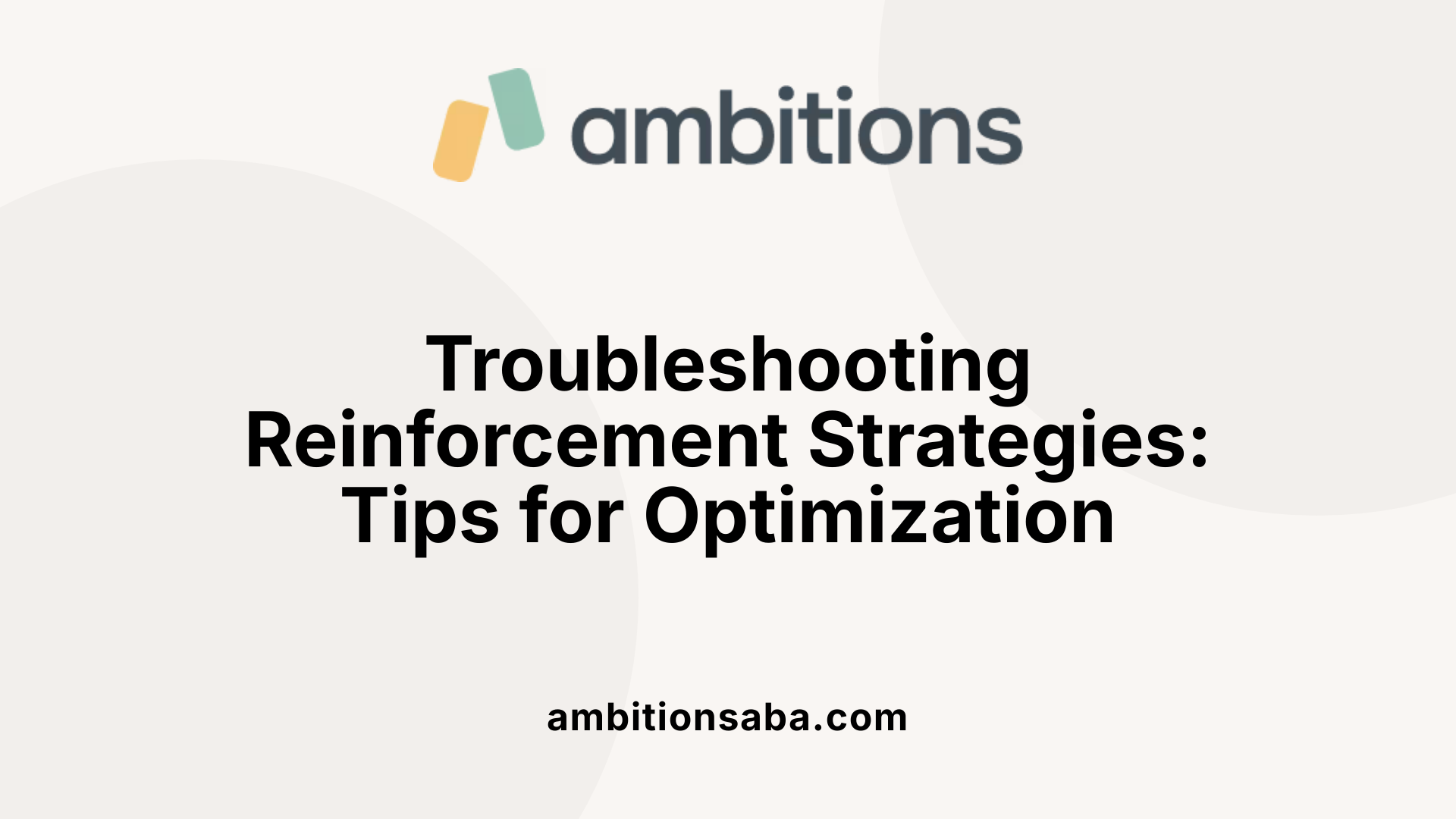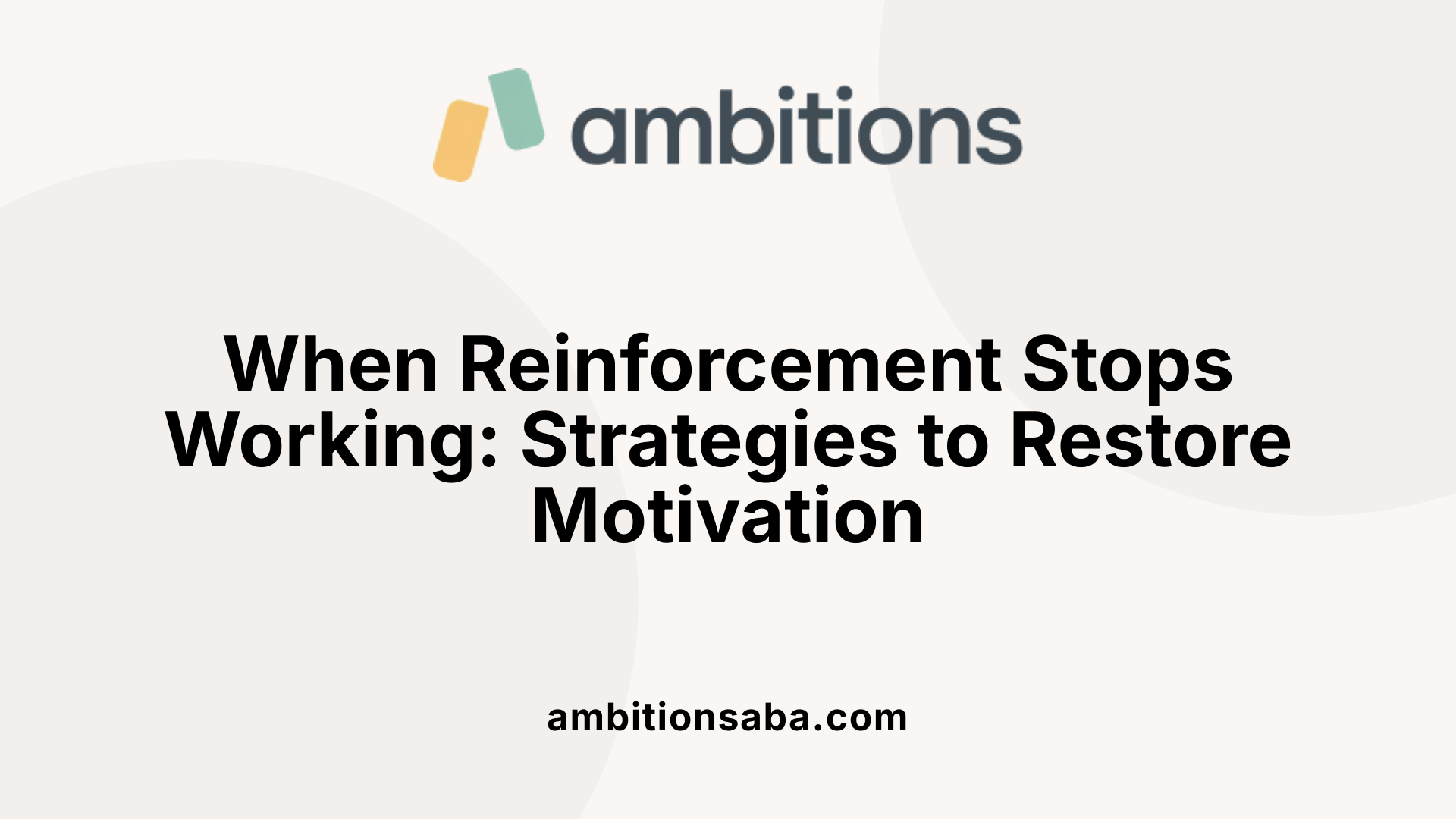Harnessing Momentum: Enhancing ABA Therapy with Behavioral Strategies
Understanding When Reinforcement Fails and How to Respond
Positive reinforcement is a cornerstone of effective behavior management, especially within educational and therapeutic settings. However, even well-planned reinforcement strategies can sometimes lose their effectiveness, leading educators and caregivers to question their approach. Recognizing why reinforcement may stop working and exploring alternative methods are crucial steps toward fostering sustainable behavioral change.
Identifying Why Reinforcement Ceases to Be Effective

Why might reinforcement stop working?
Reinforcement can fail for various reasons, and understanding these can help improve behavior management strategies. One common cause is inconsistency; if rewards are not given reliably, the learner might become confused or lose trust in the reinforcement process.
Delay in delivering the reward is another significant factor. Reinforcement is most effective when it follows immediately after the desired behavior, establishing a clear link between action and consequence. Without proper timing, the individual may not associate the reward with the specific action.
Motivational value is critical. The rewards must be meaningful and motivating enough to inspire repeated behavior. If the reward is not desirable, or if the individual grows tired of it, its effectiveness diminishes. Overuse of the same reward can lead to habituation, where the reward loses its impact due to familiarity.
Environmental and contextual elements also influence reinforcement. Distracting surroundings, high levels of stress, noise, or overstimulation can interfere with the individual noticing or responding to the reward. Training in a calmer, familiar setting often enhances success.
Aligning reinforcement with specific behaviors ensures clarity. Rewards should only be given when the target behavior is demonstrated. Inappropriate or vague reinforcement can undermine learning, as the person may not understand which behavior is being encouraged.
Overusing rewards can lead to satiation, where the individual is no longer motivated by the reinforcement, resulting in diminishing returns. Employing a variety of reinforcers can help maintain interest and effectiveness.
How do environmental factors impact reinforcement?
Environmental factors such as excessive noise, chaos, or discomfort can distract or overwhelm the learner, making it difficult to recognize or respond to reinforcement. For example, a noisy setting might prevent a child from hearing the reward signal or distract them from the task at hand.
Creating a controlled, calm environment enhances the chances that reinforcement will have its intended effect. It allows the learner to focus, process the reward, and associate it properly with the behavior. Adjustments like reducing background noise or providing a designated quiet space are practical steps.
In conclusion, ensuring reinforcement effectiveness involves maintaining consistency, timing rewards appropriately, choosing motivating reinforcers, and managing environmental conditions. Recognizing these factors can prevent reinforcement from failing and support consistent learning progress.
Troubleshooting and Fine-Tuning Reinforcement Techniques
 When reinforcement techniques do not seem to be working effectively, it’s important to evaluate several critical factors. First, check whether rewards are delivered immediately and consistently after the target behavior occurs. Giving reinforcement promptly helps the individual connect the reward with the behavior.
When reinforcement techniques do not seem to be working effectively, it’s important to evaluate several critical factors. First, check whether rewards are delivered immediately and consistently after the target behavior occurs. Giving reinforcement promptly helps the individual connect the reward with the behavior.
Next, verify if the rewards are truly motivating for the individual. Using preferred items or activities that are meaningful enhances the likelihood of reinforcing the desired behavior. Varying the types of rewards prevents satiation, which can reduce their effectiveness over time.
Adjusting how often rewards are given—known as reinforcement schedules—is also crucial. Moving from continuous reinforcement (reward every time the behavior occurs) to intermitted schedules (such as fixed or variable ratios and intervals) can maintain motivation and encourage lasting behavioral change.
Implementing differential reinforcement, where desirable behaviors are reinforced while maladaptive behaviors are ignored or suppressed, can refine outcomes. Furthermore, training replacement behaviors provides alternative responses to reinforce, helping redirect the individual in beneficial ways.
Regular data collection and progress monitoring are essential for troubleshooting. Tracking behaviors over time uncovers patterns and areas needing adjustment, ensuring reinforcement strategies are effective.
Understanding the role of reinforcement schedules is vital. Changing from constant to intermittent reinforcement prevents habituation, sustains interest, and promotes persistence. Tailoring the schedule to the individual’s needs makes the training more adaptable and successful.
In sum, troubleshooting reinforcement involves assessing timing, consistency, personalization, and schedule of rewards, then making data-informed adjustments to optimize learning and behavior change.
Strategies When Reinforcement Becomes Ineffective

What should I do when positive reinforcement no longer works?
When you notice that rewards aren't encouraging the desired behavior as effectively as before, it's time to reassess and adjust your approach. Start by evaluating whether the current reinforcers are truly appealing to the individual. Sometimes, rewards lose their appeal if they are overused or no longer match the person’s interests.
Introducing new, more engaging rewards or increasing the value of existing ones can reignite motivation. For example, switching from small treats to more exciting toys or activities can make a difference. Additionally, varying the types of rewards—such as combining tangible items, activities, or social praise—helps maintain interest.
Another effective strategy is to move from constant (continuous) reinforcement to intermittent reinforcement. This means rewarding only some instances of the desired behavior, which helps sustain interest over the long term. Combining reinforcement with clear, consistent expectations also reinforces understanding and motivation.
Are there specific techniques to maintain motivation?
Absolutely. Using diverse reinforcers tailored to individual preferences ensures the rewards remain motivating. Regularly updating rewards based on what the person enjoys prevents boredom.
Employing behavioral skills like teaching the individual to give up a reinforcer appropriately or using tools such as timers can increase engagement. For instance, setting a timer signals when the reinforcer will be available again, helping the individual anticipate and thus increase compliance.
Furthermore, creating opportunities for success and mastery fosters intrinsic motivation. When individuals experience genuine achievement, they are more likely to stay motivated, even when external rewards are not immediately present.
Maintaining motivation involves balancing external reinforcement with encouraging internal satisfaction, which supports consistent learning and development.
Understanding the Scope and Alternatives of Reinforcement
 Reinforcement is grounded in scientific principles of behavior change, primarily through operant conditioning. It works by increasing the likelihood of a behavior reoccurring when a pleasant outcome, or reinforcer, follows the behavior. For children and adults with ASD or other special needs, positive reinforcement can be a powerful tool to encourage the acquisition of new skills and adaptive behaviors.
Reinforcement is grounded in scientific principles of behavior change, primarily through operant conditioning. It works by increasing the likelihood of a behavior reoccurring when a pleasant outcome, or reinforcer, follows the behavior. For children and adults with ASD or other special needs, positive reinforcement can be a powerful tool to encourage the acquisition of new skills and adaptive behaviors.
However, reinforcement does not always produce the desired results. Reasons behind reinforcement failure include inconsistency—if the reward is not given reliably, expectations become unclear. Delays between the behavior and the reward can weaken the association. Additionally, if the reward isn’t motivating enough or is not tailored to individual preferences, it may not serve as an effective reinforcer. Environmental distractions and excessive stress or excitement levels can also interfere with learning, making it harder for the individual to connect the behavior with the reward.
When reinforcement stops working, it’s important to consider adjustments. Using more desirable or exciting rewards, ensuring timely delivery, and making rewards contingent on specific behaviors are strategies that can help. Moreover, it’s essential to verify that the reward genuinely increases the targeted behavior, as ineffective reinforcement can be counterproductive.
Beyond reinforcement, other methods can support behavior change and manage challenges. Extinction, which involves withholding reinforcement to reduce undesired behaviors, can be effective when used carefully. Visual supports—like picture schedules or social stories—provide predictable cues that help individuals understand expectations and transitions.
Proactive strategies, such as teaching coping skills or establishing routines, help prevent challenging behaviors from occurring. Logical consequences, which are related to the behavior, help individuals understand the impact of their actions in a respectful way. Token economies and other reinforcement systems can also motivate positive change while fostering a sense of control.
Behavior management should be comprehensive, combining various methods to address specific needs. A well-designed intervention plan incorporates reinforcement, visual supports, environmental modifications, and social skills training. It emphasizes positive moments, promotes cooperation, and minimizes reliance on punitive tactics.
In summary, while reinforcement remains a cornerstone of behavior intervention, understanding its limitations and supplementing it with alternative strategies can enhance outcomes. Tailoring approaches to each individual, maintaining consistency, and ensuring motivational relevance are vital for effective behavior support.
Educational and Practical Guidance for Behavior Management
Effective behavior management relies heavily on teaching educators and caregivers to use evidence-based strategies. Training programs that emphasize positive approaches, such as Positive Action, help them develop skills in setting clear expectations and using consistent praise to reinforce desired behaviors. Logical consequences tied to specific behaviors and the involvement of families in developing Behavior Intervention Plans (BIPs) are crucial for creating supportive learning environments.
Assessments like Functional Behavior Assessments (FBAs) play a pivotal role in understanding individual needs and tailoring interventions accordingly. These assessments guide the development of personalized strategies that address specific challenges, ensuring that reinforcement techniques really encourage the desired skills.
In the classroom, proactive strategies are essential. Using visual supports, social stories, and clear routines can reduce stress and prevent difficult behaviors before they occur. Visual tools help students understand what is expected and promote a sense of predictability, which is especially helpful for learners with ASD or other special needs.
When reinforcement methods are not effective, it is important for teachers and caregivers to re-evaluate their approach. Switching to more motivating or varied rewards can make a difference. Incorporating preferred items, adjusting reinforcement schedules to maintain interest, and adding supplementary strategies like self-monitoring can improve the effectiveness of behavior support plans.
Promoting self-monitoring and involving students in setting achievable goals encourages autonomy and helps sustain progress over time. These approaches foster a sense of control and responsibility, leading to more meaningful and lasting behavior change.
| Strategy | Implementation | Benefits | Additional Notes |
|---|---|---|---|
| Clear expectations | Use visual cues and consistent language | Reduces ambiguity | Tailor to individual needs |
| Reinforcement adjustments | Diversify rewards, use preferred items | Maintains motivation | Observe student preferences |
| Self-monitoring | Teach students to track behaviors | Builds independence | Start with simple tasks |
| Collaboration | Involve families and team members | Ensures consistency | Share progress regularly |
Using these strategies, educational and behavioral professionals can create an environment that encourages positive growth and reduces reliance on punitive measures. Proper training, assessment, and adaptive techniques form the foundation of effective, sustainable behavior management.
Summing Up and Moving Forward
When reinforcement stops yielding the desired behavior, a comprehensive approach involving assessment, adjustment, and alternative strategies is essential. Understanding individual motivations, environmental influences, and the importance of data-driven decisions can revitalize behavior management efforts. Using a combination of reinforcement modifications, proactive supports, and supplementary techniques ensures sustainable progress and promotes positive growth.
References
- What to do When Positive Reinforcement Isn't Working
- What Do I Do When They Won't Give Back the Reinforcer?
- How do you teach a child who doesn't respond to positive ...
- Why Positive Reinforcement Doesn't Work
- Behavior Management Strategies: Proactive & Proven ...
- Page 8: Differential Reinforcement of Alternative Behavior
- Reinforcement Strategies
- Top 10 Used Behavioral Strategies

